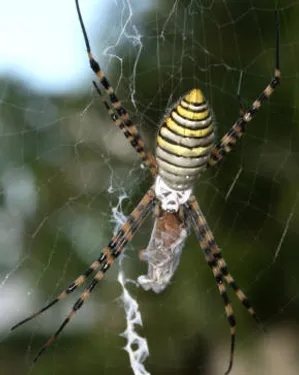
black and yellow garden spider
There are several types of Argiope spiders which live in different countries. They are not considered a dangerous spider but are venomous like all spiders.
The black-and-yellow garden spider is commonly found near houses and in gardens. The small cephalothorax (head) is tipped with silver hairs, and the slightly oval abdomen is patterned with yellow (sometimes orange) and black. A black midstripe with four white spots in the center marks the top of the abdomen. The legs are black with yellow-orange stripes. The upper portion of the legs is a more solid orange yellow. The circular webs, built only by females, can be approximately 2 feet in diameter, and the spider can be found resting head-down at the hub, where a zigzag silk band, the stabilimentum, extends vertically at the center. Males are quite small and are rarely noticed. Young females have a narrower abdomen, generally lack the yellow coloration, and have conspicuous black and white striping on their legs.
The Black and Yellow Argiopes (Argiope Aurantia) are commonly found in the United States in the Summer months. They are often called “writing” spiders because of the zigzag stablimentum which characterise their web.
This lovely spider only has a short life span and once she has produced one or more (usually no more than 3) brown, papery egg sacs, she will die. The egg sacs are roughly round in shape and up to 25 mm in diameter; each contains 300 to 1400 eggs. She attaches her egg sacs to one side of her web, close to her resting position at the centre. Each female will watch over her eggs as long as she can, but will die in the first hard frost, if not before. The eggs hatch in Autumn ( fall), but spiderlings stay in the sac during winter and emerge in spring. (Milne and Milne 1980,Heiber 1992, Faulkner 1999).
The Australian variety on the left, is the St Andrews Cross Spider, (Argiope mangal.) The St Andrew’s Cross Spider doesn’t have dangerous venom. Its bite causes a mild local pain.
These spiders get their name for the way their hold their eight legs in pairs to form an X shape like the St Andrews Cross on our national flag.
Argiope Lobata, on the right, are located around the Mediterranean and is a very common species in the Iberian Peninsula and is frequently found in zones of high grass, as well as in little dense matos, in which it constructs its web.
Gea Hepatgon on the right, is a small spider, averaging about ¼ inch in length. It has no common name. Webs are built vertically, but close to the ground, and are only a few inches across. They can sometimes be seen in the clover fern (Marsilea macropodia) that functions as groundcover in sections of the garden.
The largest and most striking of the argiope spiders is the Banded Argiope spider (Argiope trifasciata) on the left. It is found in late summer and early fall among shrubbery and in gardens where they make a highly symmetrical orb web. Females are generally silvery, with dark and yellow striping. Males are rarely observed and are much smaller than the females. The banded garden spider is harmless.
black and yellow garden spider Habitat
Skip to HabitatBlack and yellow garden spiders usually build their webs in fairly open areas as opposed to dense shrubs or inside shelters. Because all spiders are carnivores that feed primarily on insects, their presence helps rather than harms landscape and garden plants.
spiders are not a pest in the traditional sense of the word as they do not feed on crops or garden plants, but to those who are afraid of spiders it can be considered a pest. As with most spiders, Argiope spp. are beneficial organisms because they kill and consume insect pests that damage crops and garden plants.
black and yellow garden spider Food
A variety of insects may fall prey to this spider, especially grasshoppers and katydids. Once an insect is caught in the sticky strands of the web, the spider often shakes the web to make the insect more fully ensnared. Then, the spider further subdues its prey by injecting it with venom and wrapping it securely in sheets of silk. Often the spider repairs the damaged parts of its web before turning again to its prey.
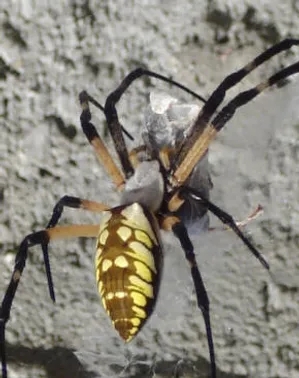
Silver Argiopes (Argiope argentata). This spider is one of nature’s many pest control agents. Its appetite for insects results in its keeping many burgeoning insect populations in check. As a group, orb-weaving spiders consume many tonnes of insects every year. You can find silver argiopes among shrubbery, tall plants and flowers in meadows and gardens. They weave a distinctive zigzag pattern within their web – an easy way to identify the presence of this particular species. They are not considered dangerous to humans although like all spiders can bite.
Life Cycle
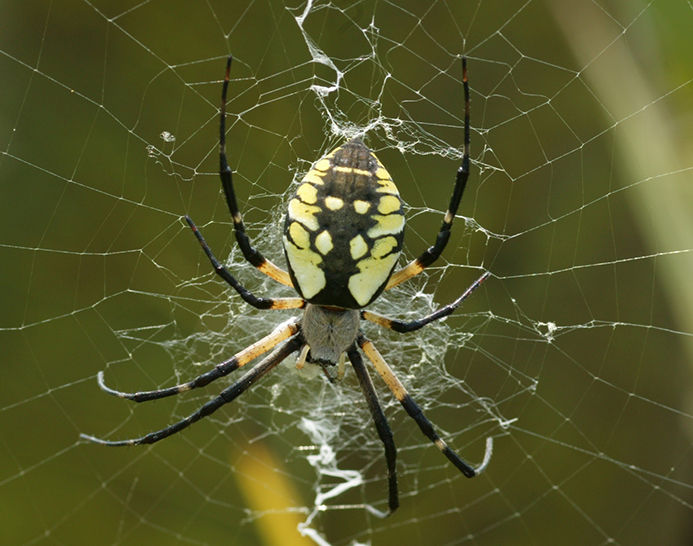
mate once a year. Mature male spiders roam in search of potential mates. Once a suitable mate has been found, the male then builds a web with a zig-zag pattern either in the middle of or on the outer area of the female’s web and begins to pluck the female’s web as a courting gesture. Once impregnated females lay one or more egg sacs in her web close to her resting position. Each egg sac contains anywhere between 300 to 1400 eggs. The mother watches over her eggs but will usually die at the first hard frost. Spiders usually hatch around autumn or summer and look similar to their adult counterparts. Most spiders usually live for around a year though some females can live for multiple years in warmer climates. Most males usually die after mating.
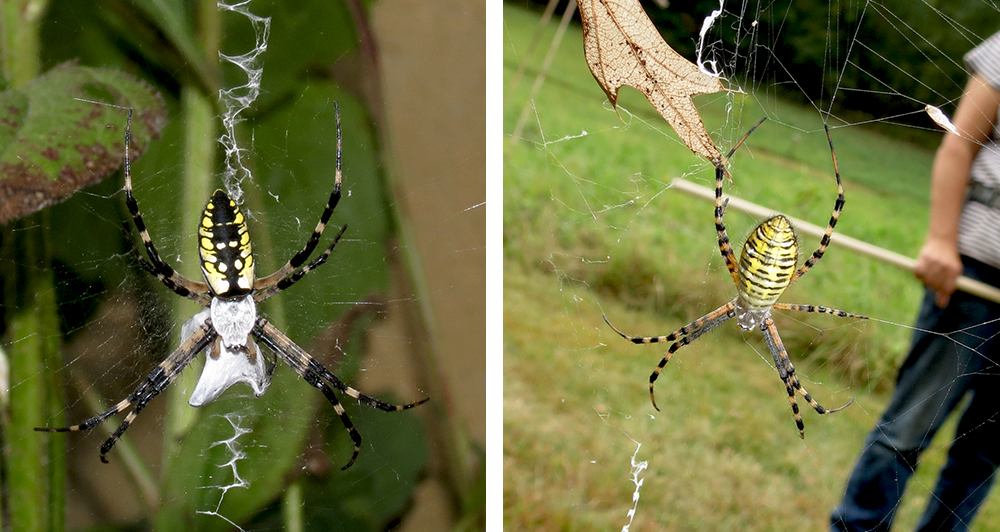
Skip to Description and Biology
Argiope aurantia is a showy spider usually noticed in late summer. It has several common names: black-and-yellow argiope, black and yellow garden spider, corn spider, golden garden spider; golden orb-weaver, writing spider, yellow garden argiope, yellow garden orb-weaver, and zipper spider. The bodies of females grow to a little more than one inch long; males are much smaller. The third pair of legs is about half as long as the other legs. Males often hold the front pairs of legs close and the hind pairs of legs close together so that the silhouette resembles a St. Andrew’s cross.
The segment to which the legs and mouthparts attach is covered with very short, shiny, white scales. The abdomen is egg-shaped and conspicuously marked with black and yellow. Females spin orb webs (spiral sticky threads suspended on non-sticky spokes) with a conspicuous white zigzag structure in the middle called the stablementum. Spider experts disagree about why these spiders spin stablementa. Earlier the stablementum was thought to give stability to the web.
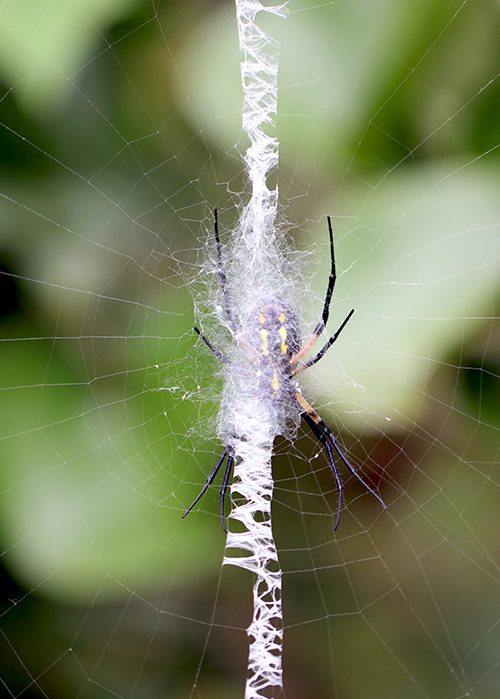
Now the thinking is that the stablementum attracts insects or keeps birds from flying through the web. All spiders are carnivores that prey primarily on insects. Black and yellow garden spiders find their prey by sensing vibrations in the web. They eat anything that doesn’t tear itself loose from the web. At night, females consume the sticky strands of the web and spin new ones. It is thought they gain some nutrition from minute insects and even miscellaneous organic matter caught in the web.
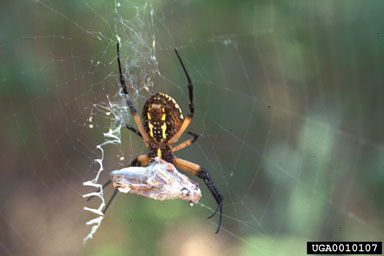
After mating in late summer or early fall, females lay several hundred to a thousand or more eggs inside a brown, silk, spherical cocoon about an inch in diameter. The spiderlings hatch but do not emerge from the cocoon until the following spring. Unfortunately for them, parasites and predators, including birds, prey upon these hapless spiderlings so that only a few survive the winter and even fewer survive to become adults the following season. There is one generation per year.
BEHAVIORS
The black-and-yellow garden spider may be found throughout Illinois. It builds its large, orb web in tall grasses and weeds in open areas. It is often present in flower and vegetable gardens. This spider sits in the center of the web with its head pointed toward the ground. It eats large, flying insects, like grasshoppers. Mature females can be seen from August through September. Males mature a week or two earlier than females. The female produces egg sacs from late August through September, placing them on plants near the web. Overwintering occurs in the cocoon, with young spiders emerging in April or May.
FEATURES
The male and female of the black-and-yellow garden spider have different appearances. The female is gray and yellow on the front part of the body (cephalothorax). Her abdomen is ovoid and rounded at the tip. The top of the abdomen has a central black stripe, and its sides have large, yellow areas separated by black stripes. The belly side of the abdomen has a black central band with yellow spots that is surrounded by a pair of long, yellow or white stripes. Her front legs are black, while all of her other legs are yellow or red close to the body and black further out. The male’s cephalothorax is brown with white hairs. The top of his abdomen has an orange-brown central band bordered by white bands. All of his legs are brown. The female is three-fourths to slightly over one inch in length. The male is about one-fourth inch long.
Native Animal Profile: Black and Yellow Garden Spider
Also affectionately known as the writing spider, the black and yellow garden spider fashions an intricate zig-zag pattern in the center of its web. This extra weave is known as a stabilimentum. The purpose of the stabilimentum is still not known. Its reflection helps larger animals (like ourselves) see the web to avoid walking through, but it also may help to attract smaller prey.
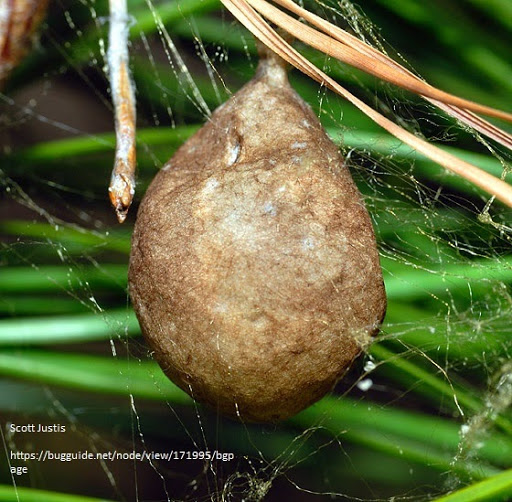
Female black and yellow garden spiders are much larger than males. Typically, the length for females (not counting legs) is ¾ to 1 inch and males are about ¼ inch in length. The head (cephalothorax) on females is tipped in silver hairs and the abdomen (butt) has a yellow and black pattern. Males often hold their front and hind legs together forming a cross-like appearance. A similar species, the banded garden spider (Argiope trifasciata), can also be found in Maryland. It has horizontal lines across the abdomen.
Black and yellow garden spiders often build their webs in open areas, such as in gardens and grasslands. As part of the orbweaver family, these spiders design intricate webs that consist of concentric rings woven together. The garden spiders rely on vibrations from critters caught in their web. They will eat just about anything that gets tangled in their sticky webs, including European hornets and yellowjackets. Sometimes, the webs can be up to two feet in diameter! At night, the black and yellow garden spider will consume its web, including any material like plant pollen that gets stuck on it. She will construct a new web the next day.
